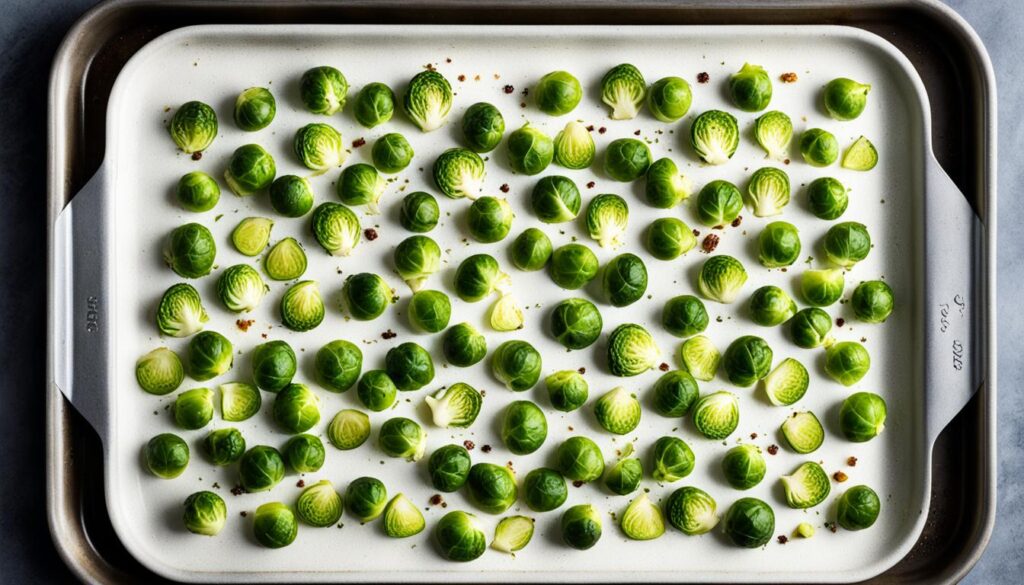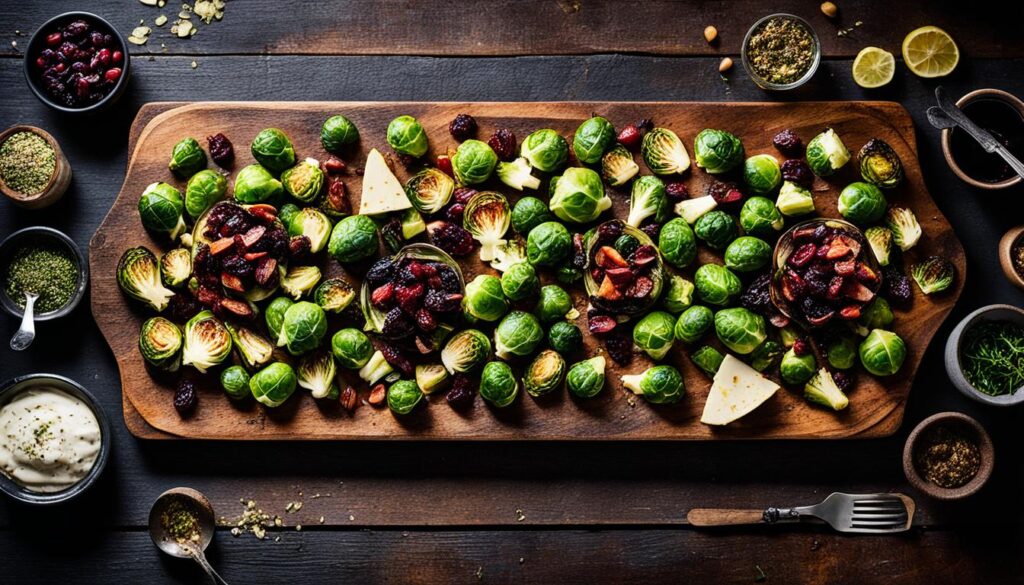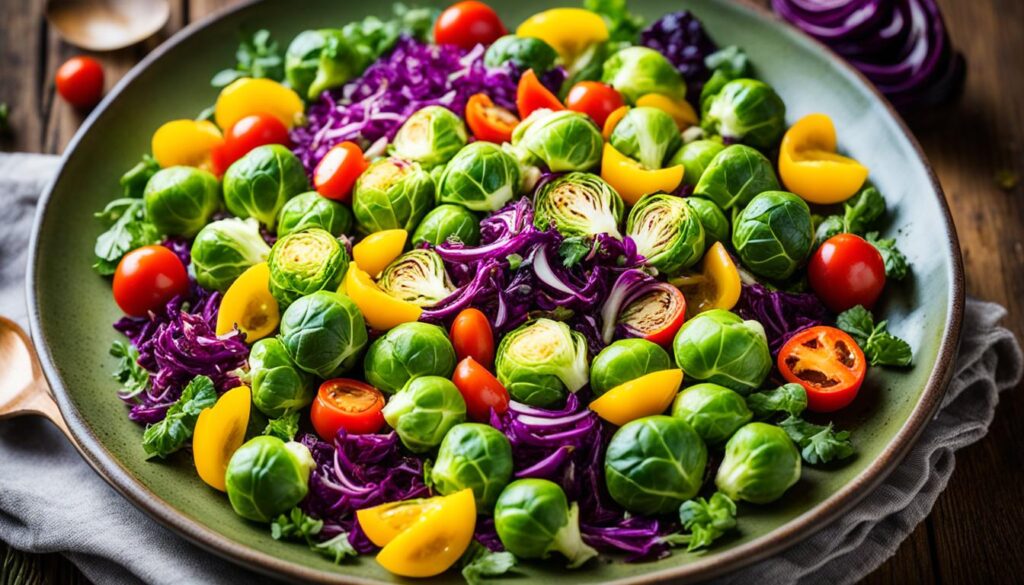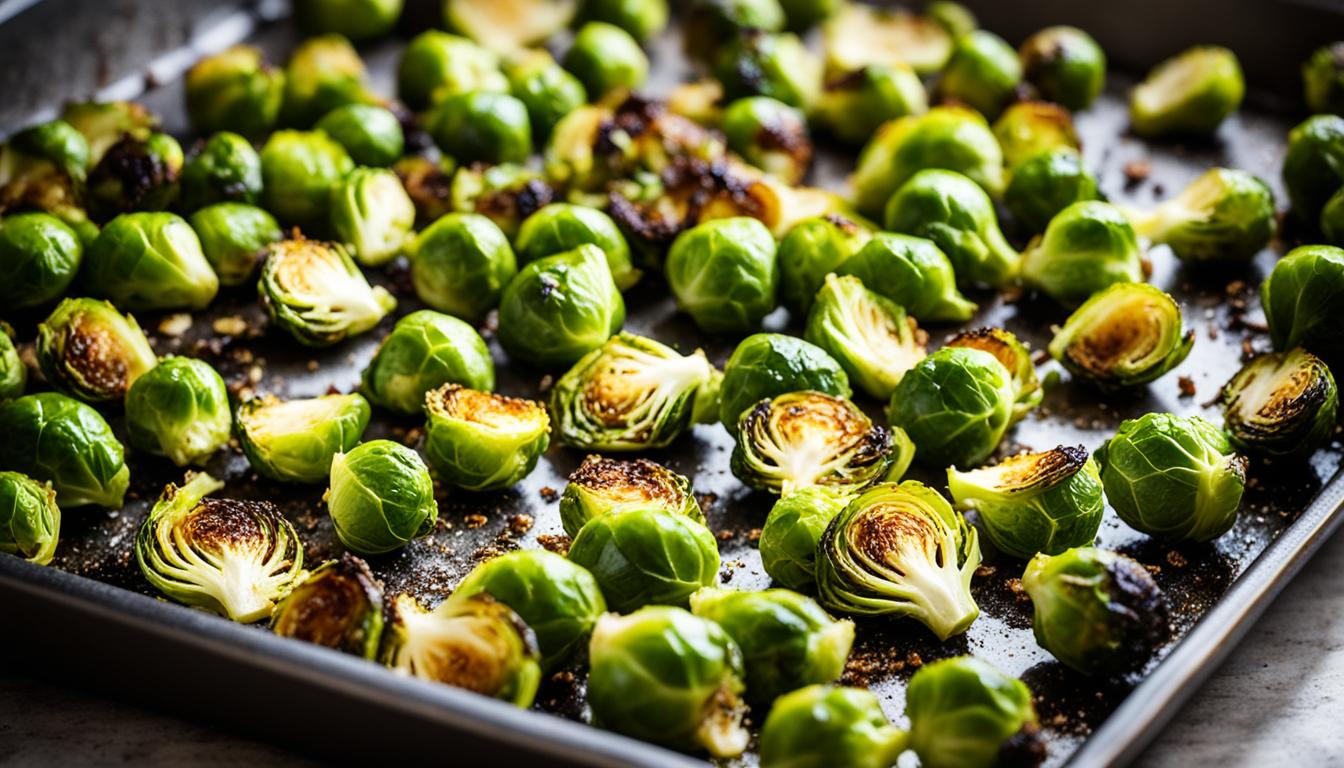Brussels sprouts may not be everyone’s favorite vegetable, but what if we told you that with the right preparation, they can be absolutely delicious? If you’ve been avoiding Brussels sprouts because of their bitter taste or mushy texture, it’s time to give them another chance. So, how exactly do you prepare Brussels sprouts to bring out their best flavors?
Join us on this easy guide where we will walk you through the steps to prepare Brussels sprouts and provide you with some flavorful recipes to try. Whether you prefer roasted Brussels sprouts, sautéed Brussels sprouts, or any other variation, we’ve got you covered!
Key Takeaways:
- Proper preparation is key to avoiding bitterness and achieving the right texture in Brussels sprouts.
- Trimming and chopping Brussels sprouts ensures even cooking.
- Seasoning with olive oil, salt, and pepper enhances the natural flavors of Brussels sprouts.
- There are various cooking methods, such as baking, roasting, sautéing, and steaming, that can be used to prepare Brussels sprouts.
- Try delicious recipes like lemon parmesan Brussels sprouts, balsamic Brussels sprouts, garlic roasted Brussels sprouts, and crispy Brussels sprouts.
Why Proper Preparation is Key
Properly preparing Brussels sprouts is essential to avoid the bitterness and mushy texture that can often come with poorly cooked sprouts. By following the right techniques, we can enhance the flavor and texture of this vegetable.
When Brussels sprouts are not prepared correctly, they can develop a strong and bitter taste that may be off-putting to some. The bitterness is caused by compounds that are released when the sprouts are overcooked or improperly cooked. However, with proper preparation, we can minimize this bitterness and bring out the natural sweetness of the sprouts.
In addition to bitterness, poorly prepared Brussels sprouts can also have a mushy texture, which can be unappetizing for many. This texture is often the result of overcooking or inadequate cooking methods. However, by using the right techniques, we can achieve a tender yet crisp texture that is much more enjoyable.
One of the keys to proper preparation is to ensure that the Brussels sprouts are cooked for the right amount of time. Overcooking can lead to both bitterness and a mushy texture. By cooking the sprouts just until they are tender and still slightly firm, we can avoid these issues.
Another important aspect of proper preparation is choosing the right cooking method. Brussels sprouts can be roasted, sautéed, or even steamed. Each method offers a different flavor profile and texture, allowing us to create a variety of delicious dishes. By experimenting with different cooking methods, we can find the perfect balance of flavor and texture for our Brussels sprouts.
By properly preparing Brussels sprouts, we can transform them into a delicious and crowd-pleasing dish. The bitterness is minimized, and the texture becomes more enjoyable. Let’s dive into the details of how to trim, chop, season, and cook Brussels sprouts to achieve the best possible results.
Quote:
We believe that proper preparation is the secret to unlocking the true potential of Brussels sprouts. By taking the time to prepare them correctly, we can enjoy their natural sweetness and avoid any unpleasant bitterness or mushy texture.
Preparation methods comparison table:
| Cooking Method | Advantages | Disadvantages |
|---|---|---|
| Roasting | – Brings out a caramelized flavor – Provides a crispy exterior – Retains nutritional value |
– Longer cooking time – Requires oven |
| Sautéing | – Quick cooking method – Enhances flavor with added ingredients – Suits various seasonings |
– Requires constant stirring – Risk of burning |
| Steaming | – Preserves natural color – Retains nutrients – Maintains a tender texture |
– Can result in a bland flavor – Requires a steaming apparatus |
How to Trim and Chop Brussels Sprouts
To prepare Brussels sprouts, start by trimming off any dry or woody stems and discarding them. Then, slice larger sprouts in half and leave smaller ones whole to ensure even cooking. By having all the sprouts a similar size, you can achieve an even texture in your dish.
Trimming and chopping Brussels sprouts is an important step in preparing them for cooking. It helps remove any tough parts and allows for even and consistent cooking. Here’s a step-by-step guide on how to trim and chop Brussels sprouts:
- Start by removing any dry or woody stems from the sprouts. These stems can be tough and unpleasant to eat, so it’s best to trim them off.
- Once the stems are removed, you can choose to slice the sprouts in half or leave them whole.
- If the sprouts are large, slicing them in half can help them cook more evenly. This ensures that the outer leaves don’t burn while the center remains undercooked.
- For smaller sprouts, leaving them whole is sufficient as they will cook through quickly.
- Remember to aim for even-sized Brussels sprouts to ensure consistent cooking. This will result in a dish with a uniform texture.
By following these steps and trimming and chopping your Brussels sprouts, you can create a dish that is visually appealing and evenly cooked.
Seasoning the Sprouts
After trimming and chopping the Brussels sprouts, it’s time to season them. The right combination of flavors can elevate this humble vegetable into a mouthwatering dish. To enhance the natural taste of Brussels sprouts, we recommend using a simple seasoning with olive oil, salt, and pepper.
Tossing the sprouts in olive oil helps to coat them evenly, adding a touch of richness and aiding caramelization during cooking. The oil also helps to prevent the sprouts from drying out and enhances their overall flavor. Remember to use a good quality extra virgin olive oil for the best results.
The addition of salt and pepper brings out the inherent flavors of the sprouts. The salt helps to balance any bitterness and adds a savory note, while the pepper provides a subtle touch of heat. Adjust the amount of seasoning according to your taste preferences, keeping in mind that a little goes a long way.
For those looking to further enhance the flavor of their Brussels sprouts, feel free to experiment with additional herbs and spices. Consider adding some minced garlic for a burst of aromatic goodness or sprinkle some crushed red pepper flakes for a hint of spice. The possibilities are endless, so don’t be afraid to get creative and tailor the seasoning to suit your personal preferences.
To summarize, seasoning the sprouts with olive oil, salt, and pepper is a simple yet effective way to bring out the best flavors in Brussels sprouts. Experiment with different seasonings to find your favorite combination and enjoy the delightful taste of these nutritious vegetables.
| Seasoning | Description |
|---|---|
| Olive Oil | Coat the sprouts, add richness, aid caramelization |
| Salt | Balance bitterness, add savory note |
| Pepper | Provide subtle heat |
| Additional Herbs and Spices | Experiment to enhance flavor and customize seasoning |
Cooking Methods for Brussels Sprouts
When it comes to preparing Brussels sprouts, there are several cooking methods you can choose from, each offering a unique flavor profile and texture. Whether you prefer a crispy and caramelized dish or a softer and more tender bite, there’s a cooking method that will suit your taste.
Baking Brussels Sprouts
Baking Brussels sprouts in the oven is a popular method that results in a delicious crispy texture. To bake Brussels sprouts, simply toss them in olive oil, season with salt and pepper, and spread them out in a single layer on a baking sheet. Roast them at 400°F (200°C) for about 20-25 minutes, or until they are golden brown and crispy. The heat of the oven will caramelize the sprouts, enhancing their natural sweetness.
Roasting Brussels Sprouts
Similar to baking, roasting Brussels sprouts also creates a crispy exterior while maintaining a tender inside. The difference lies in the higher temperature and shorter cooking time. Preheat your oven to 450°F (230°C) and roast the sprouts for 15-20 minutes. This higher temperature will create a more intense caramelization and slightly charred edges, adding depth of flavor to the dish.
Sautéing Brussels Sprouts
Sautéing Brussels sprouts in a pan is another fantastic method that allows you to develop a rich and flavorful dish. Start by heating some olive oil or butter in a skillet over medium heat. Once the oil is hot, add the sprouts and sauté them for 8-10 minutes, or until they are tender and lightly browned. The high heat and constant tossing or stirring will help the sprouts cook evenly and develop a delicious nutty aroma.
Steaming Brussels Sprouts
If you prefer a softer texture, steaming is a gentle cooking method that preserves the natural tenderness of Brussels sprouts. To steam them, place the sprouts in a steamer basket over boiling water. Cover the pot and steam them for about 6-8 minutes, or until they are tender when pierced with a fork. Steaming maintains the vibrant green color of the sprouts and retains their natural nutrients.

| Cooking Method | Texture | Flavor |
|---|---|---|
| Baking | Crispy | Caramelized |
| Roasting | Crispy | Charred, intense |
| Sautéing | Tender | Nutty |
| Steaming | Soft | Mild |
Delicious Brussels Sprouts Recipes
Looking for delicious ways to enjoy Brussels sprouts? We’ve got you covered! Check out these mouthwatering recipes that will elevate your Brussels sprouts game. From tangy lemon Parmesan Brussels sprouts to sweet and savory balsamic Brussels sprouts, there’s a recipe to suit every palate. Get ready to tantalize your taste buds with these amazing flavors!
Lemon Parmesan Brussels Sprouts
Ingredients:
- 1 pound Brussels sprouts
- 2 tablespoons olive oil
- 1 lemon, zested and juiced
- 1/4 cup grated Parmesan cheese
- Salt and pepper to taste
Instructions:
- Preheat the oven to 400°F (200°C).
- Trim the ends of the Brussels sprouts and cut them in half.
- In a bowl, toss the Brussels sprouts with olive oil, lemon zest, lemon juice, Parmesan cheese, salt, and pepper.
- Spread the Brussels sprouts evenly on a baking sheet.
- Bake for 20-25 minutes until golden brown and crispy.
- Serve hot and enjoy!
Balsamic Brussels Sprouts
Ingredients:
- 1 pound Brussels sprouts
- 2 tablespoons balsamic vinegar
- 2 tablespoons olive oil
- 2 cloves garlic, minced
- Salt and pepper to taste
Instructions:
- Preheat the oven to 425°F (220°C).
- Trim the ends of the Brussels sprouts and cut them in half.
- In a bowl, whisk together balsamic vinegar, olive oil, minced garlic, salt, and pepper.
- Add the Brussels sprouts to the bowl and toss until well coated.
- Spread the Brussels sprouts evenly on a baking sheet.
- Bake for 20-25 minutes until caramelized and tender.
- Serve warm and enjoy!
Garlic Roasted Brussels Sprouts
Ingredients:
- 1 pound Brussels sprouts
- 3 tablespoons olive oil
- 4 cloves garlic, minced
- Salt and pepper to taste
Instructions:
- Preheat the oven to 425°F (220°C).
- Trim the ends of the Brussels sprouts and cut them in half.
- In a large bowl, toss the Brussels sprouts with olive oil, minced garlic, salt, and pepper.
- Spread the Brussels sprouts evenly on a baking sheet.
- Bake for 20-25 minutes until crispy on the outside and tender on the inside.
- Serve hot and enjoy!
Crispy Brussels Sprouts
Ingredients:
- 1 pound Brussels sprouts
- Vegetable oil for frying
- 1/2 cup all-purpose flour
- 1/2 teaspoon paprika
- 1/4 teaspoon garlic powder
- 1/4 teaspoon onion powder
- Salt and pepper to taste
Instructions:
- Trim the ends of the Brussels sprouts and remove any outer leaves that are discolored.
- In a large pot, heat vegetable oil to 350°F (175°C) for frying.
- In a bowl, whisk together flour, paprika, garlic powder, onion powder, salt, and pepper.
- Toss the Brussels sprouts in the flour mixture until well coated.
- Working in batches, carefully drop the Brussels sprouts into the hot oil and fry until golden brown and crispy.
- Remove the Brussels sprouts from the oil and place them on a paper towel-lined plate to drain excess oil.
- Serve immediately and enjoy the crispy goodness!
These recipes will show you just how versatile and delicious Brussels sprouts can be. Whether you prefer the tangy flavors of lemon Parmesan Brussels sprouts, the rich taste of balsamic Brussels sprouts, the aromatic garlic roasted Brussels sprouts, or the satisfying crunch of crispy Brussels sprouts, there’s a recipe here that will satisfy your cravings. Try these mouthwatering dishes and discover a new favorite way to enjoy Brussels sprouts!
Serving Suggestions for Roasted Brussels Sprouts
Roasted Brussels sprouts are a versatile dish that can be enjoyed as a side or as the main course. They pair perfectly with a variety of ingredients, allowing you to create delicious and satisfying meals. Whether you’re looking for a tasty side dish or a hearty main dish, here are some serving suggestions to inspire your culinary creations.
1. Side Dish:
Roasted Brussels sprouts make a flavorful and nutritious addition to any meal as a side dish. Serve them alongside grilled meats, roasted chicken, or seared fish for a complete and balanced plate. Their rich earthy flavor and crispy texture will complement a wide range of main courses.
2. Main Dish:
If you want to make roasted Brussels sprouts the star of your meal, turn them into a satisfying main dish. Combine them with other roasted vegetables, such as sweet potatoes, carrots, and bell peppers, for a colorful and nutritious vegetable medley. Top it off with a protein source like grilled tofu or roasted chickpeas for a complete and filling vegan or vegetarian meal.
3. Roasted Vegetable Pasta:
Elevate your pasta dishes by adding roasted Brussels sprouts. Toss them with cooked pasta, olive oil, garlic, and your choice of herbs for a simple yet delicious pasta dish. For some added creaminess, sprinkle grated Parmesan cheese or drizzle a bit of lemon-infused olive oil over the top.
4. Grain Bowl:
Create a wholesome and nourishing grain bowl by incorporating roasted Brussels sprouts. Start with a base of cooked grains like quinoa, brown rice, or farro. Add roasted Brussels sprouts, along with other vegetables, such as cherry tomatoes, cucumbers, and avocado. Finish it off with a protein source like grilled chicken, sliced steak, or boiled eggs. Drizzle a flavorful dressing over the top for a complete and satisfying meal.

No matter how you choose to serve them, roasted Brussels sprouts are a delicious and nutritious addition to any meal. Explore different flavor combinations, experiment with various ingredients, and let your creativity guide you in creating delightful dishes that highlight the natural flavors of these tasty cruciferous vegetables.
Tips for Perfectly Cooked Brussels Sprouts
To ensure perfectly cooked Brussels sprouts, it’s important to follow a few key tips. By following these recommendations, you can achieve even cooking, a crispy texture, and delicious caramelization.
Aim for Even Cooking
One of the secrets to well-cooked Brussels sprouts is ensuring even sizing and cooking. When preparing your sprouts, make sure to chop them to a similar size. This will ensure that each sprout cooks evenly and avoids any undercooked or overcooked pieces in your dish. Whether you’re roasting or sautéing, arranging the sprouts in a single layer is also crucial. This allows the heat to distribute evenly, cooking each sprout to perfection.
Craving a Crispy Texture?
If you’re a fan of crispy Brussels sprouts, there’s a trick to achieving that desirable texture. When baking or roasting, make sure to spread out the sprouts on your baking sheet and leave a bit of space between them. This allows the heat to circulate around each sprout, helping them crisp up nicely. Additionally, flipping the sprouts halfway through the cooking process will ensure an even crispy texture on all sides.
Embrace Caramelization
For a delicious depth of flavor, caramelization is key. When baking or roasting your Brussels sprouts, don’t be afraid to let them develop a golden-brown color. The natural sugars in the sprouts will caramelize, adding a rich and slightly sweet taste. Keep an eye on them to prevent burning, but allow enough time for that beautiful caramelization to occur.
“Even cooking, a crispy texture, and caramelization can elevate your Brussels sprouts from ordinary to extraordinary.”
By following these tips, you can take your Brussels sprouts to the next level. Enjoy the perfect balance of even cooking, crispy texture, and caramelized deliciousness in every bite.
| Tips | Description |
|---|---|
| Aim for Even Cooking | Chop the sprouts to a similar size and arrange them in a single layer |
| Craving a Crispy Texture? | Spread out the sprouts with space between them when baking or roasting |
| Embrace Caramelization | Allow the sprouts to develop a golden-brown color for added flavor |
Nutritional Benefits of Brussels Sprouts
Brussels sprouts are not only delicious but also offer a plethora of nutritional benefits. These small green vegetables are low in calories yet high in fiber, making them a nutritious addition to any meal. Consuming Brussels sprouts can contribute to a balanced and healthy diet, providing essential vitamins and minerals.
Let’s take a closer look at the nutritional profile of Brussels sprouts:
- Low Calorie: Brussels sprouts are a great option for those looking to manage their calorie intake. With only around 28 calories per 1-cup serving, they can be enjoyed guilt-free while still providing significant nutritional value.
- High Fiber: Fiber is essential for a healthy digestive system, and Brussels sprouts are an excellent source. With approximately 4 grams of fiber per cup, adding Brussels sprouts to your diet can help promote regularity and maintain satiety.
- Vitamins and Minerals: Brussels sprouts are rich in essential vitamins and minerals that support overall health. They are particularly high in vitamin K, which plays a crucial role in blood clotting and bone health. Additionally, they provide a good amount of vitamin C, known for its immune-boosting properties. Brussels sprouts also contain potassium, a mineral important for heart health and muscle function.
Including Brussels sprouts in your meals can contribute to a well-rounded and nutritious diet. Their low-calorie content, high fiber content, and rich vitamin and mineral profile make them an ideal choice for those striving to maintain a healthy lifestyle.
To visualize the nutritional content of Brussels sprouts, refer to the table below:
| Nutrient | Amount per 1 cup (156g) |
|---|---|
| Calories | 28 |
| Fiber | 4g |
| Vitamin K | 156 mcg (195% of daily value) |
| Vitamin C | 75.4 mg (84% of daily value) |
| Potassium | 342 mg (7% of daily value) |

How to Store and Reheat Brussels Sprouts
If you have leftovers or want to prepare Brussels sprouts ahead of time, storage and reheating are important considerations. Here are some tips to help you store and reheat your Brussels sprouts:
- Storing Brussels Sprouts:
- Reheating Brussels Sprouts:
After cooking your Brussels sprouts, allow them to cool completely before storing them. Place the cooked sprouts in an airtight container to prevent any moisture from entering. This will help maintain their flavor and texture. Store the container in the refrigerator, where the sprouts can be kept fresh for up to 3 days.
When you’re ready to enjoy your leftover Brussels sprouts, there are two simple reheating methods you can choose from:
- Option 1: Oven: Preheat your oven to 350°F (175°C). Place the desired amount of Brussels sprouts on a baking sheet and heat them in the oven until they are warmed through, typically for about 10 minutes. Make sure to stir them occasionally to ensure even heating.
- Option 2: Microwave: If you prefer a quicker reheating method, you can use a microwave. Transfer the desired amount of Brussels sprouts to a microwave-safe dish and cover them with a microwave-safe lid or microwave-safe plastic wrap. Heat them on medium power for about 1-2 minutes, stirring halfway through to ensure even heating.
Pro Tip:
When reheating Brussels sprouts, be careful not to overcook them. Overcooking can lead to a mushy texture and a loss of flavor. It’s best to heat them until they are just warmed through.
We Don’t Recommend Reheating Brussels Sprouts Multiple Times
While it is safe to reheat Brussels sprouts, we don’t recommend reheating them multiple times. Each time you reheat them, they can become softer and lose their texture. It’s best to reheat only the amount you plan to consume to maintain the best flavor and quality.
Now that you know how to store and reheat your Brussels sprouts, you can enjoy them even as leftovers. Reduce food waste and savor the deliciousness of your Brussels sprouts for another meal!
| Storage Tips for Brussels Sprouts | Reheating Methods |
|---|---|
| Allow the cooked sprouts to cool completely. Store in an airtight container in the refrigerator. Keep for up to 3 days. |
Option 1: Oven – 350°F (175°C) for 10 minutes. Option 2: Microwave – 1-2 minutes on medium power. |
Conclusion
In conclusion, our easy guide to preparing Brussels sprouts provides you with the knowledge and inspiration to create delicious and healthy dishes. By following the steps outlined in this guide and trying different recipes, you can elevate the humble Brussels sprout into a flavorful and satisfying addition to your meals.
The versatility of Brussels sprouts allows you to experiment with different flavors and cooking methods. Whether you prefer them roasted, sautéed, or steamed, there are endless possibilities to explore. Don’t be afraid to get creative and try unique combinations of herbs, spices, and seasonings to find your favorite preparation style.
By incorporating Brussels sprouts into your meals, you can reap the nutritional benefits they offer. These leafy green vegetables are low in calories and high in fiber, making them a nutritious choice. They are also packed with essential vitamins and minerals, including vitamin K, vitamin C, and potassium.
So, why not embark on a culinary adventure with Brussels sprouts? Use this easy guide, experiment with different recipes, and savor the delicious and healthy outcomes. Whether you’re a seasoned sprout enthusiast or new to this vegetable, there’s always something new to discover and enjoy.
